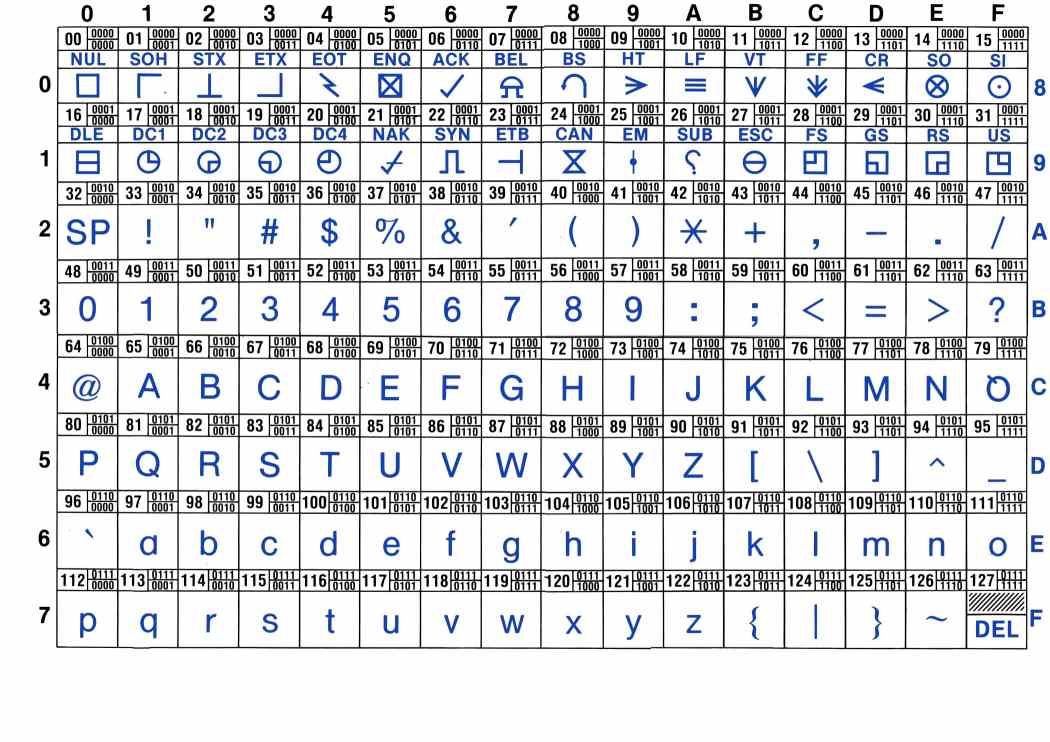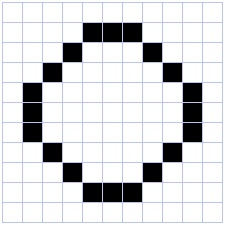
ascii table
There are 10 kinds of people: those who count in binary and the others.
Computers represent everything as series of 0 and 1, also known as bits (for “binary digits”).
Just like a number can be written in base 10, it can be written in base 2 (or in any other base):
12 = 10 + 2 = 1.(10^1) + 2.(10^0)
12 = 8 + 4 = 2^3 + 2^1 => 1010
33 = 30 + 3 = 3.(10^1) + 3.(10^0)
33 = 32 + 1 = 2^5 + 2^0 => 100001The binary representions of the first integers:
1 : 1
2 : 10
3 : 11
4 : 100
5 : 101
6 : 110
7 : 111
...Remember that a number represented by four digits “d3 d2 d1 d0” in a basis ‘b’, has a value of d3b^3 + d2b^2 + d1b^1 + d0b^0
To learn more about how integer numbers are represented in binary format, you can check out http://csunplugged.org/binary-numbers
. . .
Answer: 5, 8, 11, 255
. . .
def todec8bits(s):
return int(s[0])*128 + int(s[1])*64 + int(s[2])*32 + \
int(s[3])*16 + int(s[4])*8 + int(s[5])*4 + \
int(s[6])*2 + int(s[7])
todec8bits("01010101")One issue with this code:
todec8bits("0101010")
todec8bits("010101010")Remark: on your computers, integers are represented either as 32 or 64 bits, depending on your processor/operating system.
Why is this is relevant: suppose you perform an EEG recording with 256 electrodes every milliseconds for one hour. How large is the data?
Beware: your computer can make mistakes if you add too large numbers!!!
Another solution demonstrating several new Pythonic constructions that we have not seen yet:
pow2 = [2 ** n for n in range(7, -1, -1)]
n = 0
for b, p in zip(s, pow2):
n += int(b) * p
print(n). . .
We could modify it to adapt to the size of the string ‘s’.
My favorite which has the advantage of working with strings of unlimited size:
def todec(s):
""" convert a string of 0 and 1 representing a binary number into an integer """
n = 0
for b in s:
n = n * 2 + int(b)
return n
for i in ['101', '1000', '1011', '11111111']:
print(todec(i))If you have an idea how to program it, please proceed. If not, we propose that you follow the following steps:
num = 143
d3 = int(num/1000) % 10 # thousands
d2 = int(num/100) % 10 # hundreds
d1 = int(num/10) % 10 # dec
d0 = num % 10
print(str(d3) + str(d2) + str(d1) + str(d0)). . .
num = 17
b0 = num % 2
b1 = int(num/2) % 2
b2 = int(num/4) % 2
b3 = int(num/8) % 2
b4 = int(num/16) % 2
b5 = int(num/32) % 2
b6 = int(num/64) % 2
b7 = int(num/128) % 2
b8 = int(num/256) % 2
print(str(b8) + str(b7) + str(b6) + str(b5) + str(b4) + str(b3) + str(b2) + str(b1) + str(b0)). . .
. . .
def tobin(num):
b7 = int(num/128) % 2
b6 = int(num/64) % 2
b5 = int(num/32) % 2
b4 = int(num/16) % 2
b3 = int(num/8) % 2
b2 = int(num/4) % 2
b1 = int(num/2) % 2
b0 = num % 2
return (str(b7) + str(b6) + str(b5) + str(b4) + \
str(b3) + str(b2) + str(b1) + str(b0))
for n in range(256):
print(n, tobin(n)). . .
. . .
def binary(n):
if n==0:
return "0"
s = ""
while n > 0:
b = str(n % 2)
s = b + s
n = n / 2
return s. . .
def binary(num):
if num == 0:
return "0"
if num == 1:
return "1"
return(binary(int(num /2)) + binary(num % 2))
print(binary(1234)). . .
Answer: It is a recursive function which calls itself. See http://en.wikipedia.org/wiki/Recursion_%28computer_science%29
. . .
Remark: measures of memory size
Exercice (advanced): Write a function that return the hexadecimal representation (base 16) of a number.
To go further:
If you want to know how negative integer numbers are represented, see http://en.wikipedia.org/wiki/Two%27s_complement
To understand how real numbers are encoded, read What Every Programmer Should Know About Floating-Point Arithmetic and https://docs.python.org/2/tutorial/floatingpoint.html#tut-fp-issues
A text file is nothing but a sequences of characters.
For a long time, characters were encoded using ASCII code.

ascii table
In Python, you can know the code of a character with the function ord:
print(ord('a'))
print(ord('@'))The inverse of ord is chr.
chr function of Python to print it.. . .
For example, if you name is ‘ZOE’, you would type:
print(chr(90)+chr(79)+chr(69))Remark: ASCII codes use one byte (=8bits) per character. This is fine for English, but cannot cover all the caracters of all alphabets. It cannot even encode french accented letters.
Unicode was invented that associate a unique 2 bytes number to each character of any human script. It is possible to write text files using these number, but more economic to encode the most common letters with one byte, and keep the compatibility with ASCII (UTF-8).
print("".join([unichr(c) for c in range(20000, 21000)]))In Python, text can be stored in objects called strings.
String constants are enclosed between single quotes
'Bonjour le monde!'Or double quotes
"Bonjour le monde !"Or “triple” quotes for multilines strings
"""
Bonjour le monde!
Longtemps je me suis levé de bonne heure,
Les sanglots longs des violons,
...
"""They have a type ‘str’.
>>> type('bonjour')
<type 'str'>To convert an object to a string representation:
str(10)
a = dict((("a",1), ("b",2)))
str(a)A string is nothing but a sequence of characters.
a = 'bonjour'
print(a[0])
print(a[1])
print(a[2])
print(a[2:4])
print(len(a))
for c in 'bonjour':
print(c)Operations on strings
a = 'bonjour'
b = 'hello'
a + b
a + ' ' + bA set of functions to manipulate strings is available in the module ‘string’.
import string
string.upper(a)
string.lower('ENS')a = 'alain marie jean marc'
a.find('alain')
a.find('marie')
a.find('ma')
a.find('marc')
a.find('o')
a.replace('marie','claude')
aa = 'alain marie jean marc'
a.split(" ")Read (see https://docs.python.org/2/library/string.html) to learn about more string functions.
name = raw_input('Comment vous appelez-vous ? ')
print "Bonjour " + name + '!'f = file('test.txt')
o = f.read()
print(o)
lines = o.split("\n")
print(lines)Download Alice in Wonderland
f = file('alice.txt')
o = f.read()
print(o)
lines = o.split("\\n")
print(lines). . .
f = file('alice.txt')
o = f.read()
print(o)
lines = o.split("\n")
nlines = len(lines)
nw = 0
for l in lines:
nw += len(l.split(" "))
print(nlines)
print(nw). . .
def spot_nsa(filename):
f = file(filename)
o = f.read()
lines = o.split("\n")
found = False
for l in lines:
if "NSA" in l.split(" "):
found = True
break
return foundImages can be stored either:
Here we are just going to manipulate bitmaps.
Each dot (pixel) is either ‘0’ (black) or ‘1’ (white).

. . .
Answer: 1024*768/8/1024=96 KB
import numpy as np
import matplotlib.pyplot as plt
a = np.array([[0, 0, 0, 0, 0, 0, 0],
[0, 0, 1, 1, 1, 0, 0],
[0, 0, 1, 1, 1, 0, 0],
[0, 0, 1, 0, 1, 0, 0],
[0, 0, 1, 1, 1, 0, 0],
[0, 0, 1, 1, 1, 0, 0],
[0, 0, 0, 0, 0, 0, 0]])
plt.imshow(a, cmap=plt.cm.gray, interpolation='nearest')
plt.show()Numpy’s arrays are a new type of object. There are similar to lists, but optimised for mathematical computations. Notably, they can be multidimensional (i.e. you can use a[i,j] notation). You can learn more about arrays in the documents http://www.pallier.org/cours/AIP2013/python4science.pdf and http://wiki.scipy.org/Tentative_NumPy_Tutorial.
Here is another example:
. . .
a = np.zeros((200,200))
for i in range(200):
a[i, i] = 1
plt.imshow(a, cmap=plt.cm.gray, interpolation='nearest')
plt.show()
a[0:200:2,] = 1
plt.imshow(a, cmap=plt.cm.gray, interpolation='nearest')
plt.show()Each dot is now associated to an integer value, e.g. ranging from 0 to 255 for 8-bits codes, coding for a grey level (smaller=darker). Each dot needs one byte.
How large is the file for an image 1024x768 pixels with 256 grey levels?
The following code displays an image:
import scipy.misc
l = scipy.misc.lena()
plt.imshow(l, cmap=plt.cm.gray)
plt.show()This code runs a low pass (averaging) filter on it:
import scipy.ndimage
bl = scipy.ndimage.gaussian_filter(l, 3)
plt.imshow(bl, cmap=plt.cm.gray)
plt.show()Edge detector It is easy to implement an edge detector with a neural network. See https://courses.cit.cornell.edu/bionb2220/UnderstandingLateralInhibition.html.
Using the ndimage.convolve function, apply the following filters to the image and diplay the results.
kernel1 = np.array([[-1, -1, -1],
[-1, 8, -1],
[-1, -1, -1]])
bl=scipy.ndimage.convolve(l,kernel1)
plt.imshow(bl, cmap=plt.cm.gray)
plt.show()
kernel2 = np.array([[-1, -1, -1, -1, -1],
[-1, 1, 2, 1, -1],
[-1, 2, 4, 2, -1],
[-1, 1, 2, 1, -1],
[-1, -1, -1, -1, -1]])
bl=scipy.ndimage.convolve(l,kernel2)
plt.imshow(bl, cmap=plt.cm.gray)
plt.show()More manipulations are available at http://scipy-lectures.github.io/advanced/image_processing/.
Each dot is now associated to three bytes, representing the Red, Gree and Blue intensities (see http://www.colorpicker.com/).
How large is the file for a 1024x768 RGB image?
Exercice: What are the RGB triplets for BLACK, WHITE, RED, YELLOW?